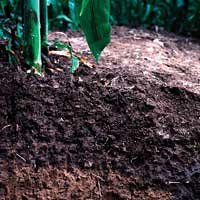
-
Diseases
- Asian Rust
- Anthracnose
- Bacterial Blight
- Bacterial Pustule
- Bean Pod Mottle Virus
- Brown Stem Rot
- Cercospora Leaf Blight
- Charcoal Rot
- Downy Mildew
- Frogeye Leaf Spot
- Green Stem Syndrome
- Iron Deficiency Chlorosis
- Phytophthora Root & Stem Rot
- Powdery Mildew
- Rhizoctonia
- Seedling Diseases
- Septoria (Brown Spot)
- SCN (Soybean Cyst Nematode)
- Soybean Mosaic Virus
- Stem Canker
- Sudden Death Syndrome
- Viruses
- White Mold
- Pests
- Biological Control
- Agronomics
- Diagnostic Tools
- About Us
- Library
Soils and Soil Fertility
 |
| Soil is the medium for plant growth. Photo credit: Lynn Betts, NRCS |
 |
| Cover crops can have numerous benefits such as the improvement of soil quality, pest management, fertility management, water availability, landscape diversification, and wildlife habitat. |
Soil is the growing medium of crops. It consists of four parts: solid minerals (sand, silt and clay), water, air, and organic matter. The soil water contains dissolved nutrients and is the main source of water for plants.The air provides roots with oxygen and removes excess carbon dioxide. The organic matter component consists of living organisms, fresh residues, and decomposed residues. The organic matter component plays a significant role in maintaining soil fertility, soil structure, and plant health.
Nutrient requirements for soybean
Like all plants, soybeans require nitrogen (N), phosphorus (P) and potassium (K), as well as several secondary nutrients such as calcium, magnesium, iron, boron, manganese, sulfur, zinc, copper, molyybdenum, and other nutrients for their growth and health. The plants obtain these nutrients from the soil. When nutrients are limited, basic processes such as water transport, photosynthesis, and protein, oil, and carbohydrate production do not occur at proper rates, and growth declines.
Soybean is a legume and will normally provide itself nitrogen through a symbiotic relationship with N-fixing bacteria in the soil. These bacteria, generally called nodule bacteria or rhizobia form nodules (small swellings) on the root system of legumes that house the rhizobia.
Nutrient deficiencies in soybean crops are rare, and the current recommendation of most Extension agronomists in the region is to apply additional nutrients as fertilizer only if soil tests indicate that a specific nutrient is at a low concentration, or if deficiencies are identified in the field. Research conducted throughout the region has shown that nitrogen application at planting does not improve yield and only decreases nodulation while increasing the plant’s dependency on the soil for nitrogen. High nitrogen fertility actually inhibits the ability of the bacteria to convert atmospheric nitrogen into available N.

